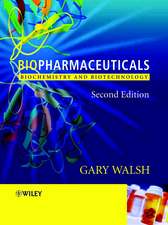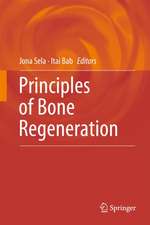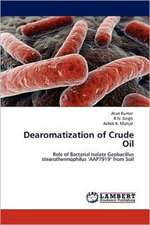Nanomedicine in Drug Delivery
Editat de Arun Kumar, Heidi M. Mansour, Adam Friedman, Eric R. Bloughen Limba Engleză Hardback – 5 iun 2013
Featuring contributions by leading researchers from around the world, the book examines:
- The integration of nanoparticles with therapeutic agents
- The synthesis and characterization of nanoencapsulated drug particles
- Targeted pulmonary nanomedicine delivery using inhalation aerosols
- The use of biological systems—bacteria, cells, viruses, and virus-like particles—as carriers to deliver nanoparticles
- Nanodermatology and the role of nanotechnology in the diagnosis and treatment of skin disease
- Nanoparticles for the delivery of small molecules, such as for gene and vaccine delivery
- The use of nanotechnologies to modulate and modify wound healing
- Nanoparticles in bioimaging, including magnetic resonance, computed tomography, and molecular imaging
- Nanoparticles to enhance the efficiency of existing anticancer drugs
- The development of nanoparticle formulations
- Nanoparticles for ocular drug delivery
- Nanoparticle toxicity, including routes of exposure and mechanisms of toxicity
- The use of animal and cellular models in nanoparticles safety studies
| Toate formatele și edițiile | Preț | Express |
|---|---|---|
| Paperback (1) | 585.27 lei 6-8 săpt. | |
| CRC Press – 29 mar 2017 | 585.27 lei 6-8 săpt. | |
| Hardback (1) | 1394.89 lei 6-8 săpt. | |
| CRC Press – 5 iun 2013 | 1394.89 lei 6-8 săpt. |
Preț: 1394.89 lei
Preț vechi: 1701.08 lei
-18% Nou
Puncte Express: 2092
Preț estimativ în valută:
266.95€ • 277.67$ • 220.38£
266.95€ • 277.67$ • 220.38£
Carte tipărită la comandă
Livrare economică 14-28 aprilie
Preluare comenzi: 021 569.72.76
Specificații
ISBN-13: 9781466506169
ISBN-10: 1466506164
Pagini: 470
Ilustrații: 72 b/w images and 29 tables
Dimensiuni: 156 x 234 x 25 mm
Greutate: 0.84 kg
Ediția:New.
Editura: CRC Press
Colecția CRC Press
ISBN-10: 1466506164
Pagini: 470
Ilustrații: 72 b/w images and 29 tables
Dimensiuni: 156 x 234 x 25 mm
Greutate: 0.84 kg
Ediția:New.
Editura: CRC Press
Colecția CRC Press
Public țintă
Academic and PostgraduateCuprins
Nanoparticles in Drug Delivery Systems. Synthesis and Characterization of Nanoencapsulated Drugs. Nanoparticle Lung Delivery and Inhalation Aerosols for Targeted Pulmonary Nanomedicine. Biological Systems for the Delivery of Nanoparticles. Nanodermatology: The Giant Role of Nanotechnology in Diagnosis and Treatment of Skin Disease. Nanoparticles for Drug Delivery of Small Molecules. Nanoparticle Therapies for Wounds and Ulcer Healing. Nanoparticles in Bioimaging. Nanoparticles in Anticancer Drug Delivery. Formulations of Nanoparticles in Drug Delivery. Nanoparticles for Ocular Drug Delivery. Toxicology of Nanoparticles. Animal and Cellular Models for Use in Nanoparticles Safety Study. Index.
Notă biografică
Arun Kumar, Ph.D., is an assistant professor in the Department of Medical Laboratory Science and the Department of Biomedical Engineering at the University of Delaware. Dr. Kumar has filled in more than 26 patents on his research related to biosensors and nanotechnology. He has presented his work at more than 60 international conferences worldwide, published more than 35 peer-reviewed research articles and two book chapters, and is an editorial board member of Sensors and Transducers Journal.
Heidi M. Mansour, Ph.D., RPh, is an assistant professor of pharmaceutics and drug delivery at the University of Kentucky College of Pharmacy, a faculty associate at the University of Kentucky Center of Membrane Sciences, and a graduate faculty member at the University of North Carolina-Chapel Hill. She serves on the editorial advisory boards of eight journals in drug delivery and nanomedicine, is a member of the NIH U.S. Pediatric Formulations Initiative New Drug Delivery Systems Aerosols Working Group, and is a delegate to the U.S. Pharmacopeia (USP). Dr. Mansour has published more than 40 peer-reviewed scientific publications, five book chapters, and more than 80 abstracts.
Adam Friedman, MD, FAAD, is an assistant professor of dermatology and physiology/biophysics and serves as director of the Dermatologic Research at the Unified Division of Dermatology of Albert Einstein College of Medicine. Dr. Friedman investigates novel nanotechnologies that allow for controlled and sustained delivery of a wide spectrum of physiologically and medicinally relevant molecules. He holds several patents and has published more than 80 papers/chapters on his research as well as on a variety of clinical areas in dermatology. Dr. Friedman recently published the first textbook on nanotechnology and dermatology and serves as vice president of the Nanodermatology Society.
Eric Blough, Ph.D., is an associate professor and director of pharmacology and toxicology at the School of Pharmacy at Marshall University. In addition to his academic duties he is also the director for the Center for Diagnostic Nanosystems. A prolific researcher and publisher, Dr. Blough and his colleagues have received over $11 million in research awards since 1998 and published more than 150 scientific manuscripts, technical reports, and abstracts—all while maintaining a strong focus on student development and mentoring in his teaching.
Heidi M. Mansour, Ph.D., RPh, is an assistant professor of pharmaceutics and drug delivery at the University of Kentucky College of Pharmacy, a faculty associate at the University of Kentucky Center of Membrane Sciences, and a graduate faculty member at the University of North Carolina-Chapel Hill. She serves on the editorial advisory boards of eight journals in drug delivery and nanomedicine, is a member of the NIH U.S. Pediatric Formulations Initiative New Drug Delivery Systems Aerosols Working Group, and is a delegate to the U.S. Pharmacopeia (USP). Dr. Mansour has published more than 40 peer-reviewed scientific publications, five book chapters, and more than 80 abstracts.
Adam Friedman, MD, FAAD, is an assistant professor of dermatology and physiology/biophysics and serves as director of the Dermatologic Research at the Unified Division of Dermatology of Albert Einstein College of Medicine. Dr. Friedman investigates novel nanotechnologies that allow for controlled and sustained delivery of a wide spectrum of physiologically and medicinally relevant molecules. He holds several patents and has published more than 80 papers/chapters on his research as well as on a variety of clinical areas in dermatology. Dr. Friedman recently published the first textbook on nanotechnology and dermatology and serves as vice president of the Nanodermatology Society.
Eric Blough, Ph.D., is an associate professor and director of pharmacology and toxicology at the School of Pharmacy at Marshall University. In addition to his academic duties he is also the director for the Center for Diagnostic Nanosystems. A prolific researcher and publisher, Dr. Blough and his colleagues have received over $11 million in research awards since 1998 and published more than 150 scientific manuscripts, technical reports, and abstracts—all while maintaining a strong focus on student development and mentoring in his teaching.
Recenzii
"This is a very timely comprehensive overview of a new and exciting field on the use of nanotechnologies in developing novel treatment strategies and diagnosis of diseases. I highly recommend this book to anyone working in the field of nanomedicine. Weighted numerical score: 90 - 4 stars!"
—Thomas L. Pazdernik, Ph.D, University of Kansas Medical Center, Kansas City, USA, from Doody’s Book Reviews™
"The book covers a wide range of interesting topics, which are well organized, covering both the physicochemical characterization of the drug delivery systems and their potential clinical applications. ... In the upcoming decade, nanotechnologies are expected to provide innovative delivering devices to meet crucial clinical needs. In this context, the main strength of this book is to provide a comprehensive discussion about the most promising approaches for diagnosis and treatment of diseases. The editors are worldwide recognised experts in the field and have gathered a team of contributors to cover the several applications of nanosized materials in medical and life-sciences fields. This book will help both beginners and experienced professionals working in the field of drug delivery."
—Eliana B. Souto, Faculdade de Ciências da Saúde, Universidade Fernando Pessoa, Porto, Portugal
"... gives readers a good, balanced, and realistic evaluation of existing nanomedicine developments and future prospects—a strong foundation upon which to plan future pharmaceutical formulation designs of nanomedicine. ... covers an important field, which has a great potential and promises for optimization of advanced drug therapy and diagnostics. There is no doubt that nanotechnology and nanomedicine will be an even more important part of the tool box for pharmaceutical scientist and other health professionals involved in drug development in order to obtain advances in medicine and to improve the future of healthcare to the benefit of patients."
—Sven Frokjaer, Professor, Ph.D., University of Copenhagen, Denmark
—Thomas L. Pazdernik, Ph.D, University of Kansas Medical Center, Kansas City, USA, from Doody’s Book Reviews™
"The book covers a wide range of interesting topics, which are well organized, covering both the physicochemical characterization of the drug delivery systems and their potential clinical applications. ... In the upcoming decade, nanotechnologies are expected to provide innovative delivering devices to meet crucial clinical needs. In this context, the main strength of this book is to provide a comprehensive discussion about the most promising approaches for diagnosis and treatment of diseases. The editors are worldwide recognised experts in the field and have gathered a team of contributors to cover the several applications of nanosized materials in medical and life-sciences fields. This book will help both beginners and experienced professionals working in the field of drug delivery."
—Eliana B. Souto, Faculdade de Ciências da Saúde, Universidade Fernando Pessoa, Porto, Portugal
"... gives readers a good, balanced, and realistic evaluation of existing nanomedicine developments and future prospects—a strong foundation upon which to plan future pharmaceutical formulation designs of nanomedicine. ... covers an important field, which has a great potential and promises for optimization of advanced drug therapy and diagnostics. There is no doubt that nanotechnology and nanomedicine will be an even more important part of the tool box for pharmaceutical scientist and other health professionals involved in drug development in order to obtain advances in medicine and to improve the future of healthcare to the benefit of patients."
—Sven Frokjaer, Professor, Ph.D., University of Copenhagen, Denmark
Descriere
Recent breakthroughs in nanomedicine are now making it possible to deliver drugs and therapeutic proteins to local areas of disease or tumors to maximize clinical benefit while limiting unwanted side effects. This book gives an overview of aspects of nanomedicine to help readers design and develop novel drug delivery systems and devices that build on nanoscale technologies. Contributors explore the use of nanoparticles in inhalation aerosols, nanodermatology, wound healing, bioimaging, anticancer drug delivery, ocular drug delivery, and more. They also discuss nanotoxicity and safety studies.














